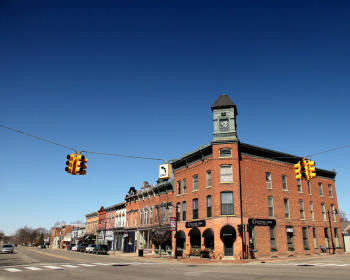Clinton
 On the northern border of Lenawee County, the village of Clinton offers visitors a rich history that dates to the 1820s when it was built on the Old Sauk Trail, now part of the U.S. 12 Heritage Trail which was only the second federal highway in the United States that was built along an ancient Indian trail in lower Michigan. Clinton is home to one of Lenawee County’s largest and longest running fall festivals.
On the northern border of Lenawee County, the village of Clinton offers visitors a rich history that dates to the 1820s when it was built on the Old Sauk Trail, now part of the U.S. 12 Heritage Trail which was only the second federal highway in the United States that was built along an ancient Indian trail in lower Michigan. Clinton is home to one of Lenawee County’s largest and longest running fall festivals.
History
In the beginning the Sauk and Pottawatomie Indians carved a trail from the Detroit River across southern Michigan and down the Mississippi River. This trail was known as the "Great Sauk Trail". Its origins go back 10,000 years to when the last glaciers retreated. Animals carved tracks along the high ground between the swamp and rubble created by the glacier. The Indian trail followed the animal route.
The Great Sauk Trail once brought the Sauk, Seneca, Shawnee and Pottawatomie Indians near the spot they called "Oak Opening" because of a natural opening among the oak trees found in this area.
During the 1820’s, a stagecoach ran semi-weekly between Detroit, Ypsilanti, and Tecumseh. By 1835, a daily stagecoach was running between Detroit and Chicago. In the early days Clinton was a stagecoach stop and wholesale center along the Chicago Pike.
It became an important center of trade because of its location on the Chicago Road and the River Raisin.
Only a decade after its settlement, the Village had ten general stores, several blacksmith shops, and a hardware store. The Atlas Feed and Grain Company was established in 1836. The company is located at Franklin Street on the River Raisin.
The mill has the distinction of being the oldest business in Clinton and the second oldest business in the state.
The Clinton Inn located on the northwest corner of US-12 and Jackson Road is the only hotel still in operation in Clinton. The Inn was built by Alonzo Clark in 1900. The Clintonian was a popular resting place for travelers. In the summer, the Inn was filled with tourists who came to enjoy the activities in the Irish Hills.
The original Clinton Inn, currently relocated to Greenfield Village, was constructed in 1830, by Calvin Parkhurst. It was built of black walnut, seventy-six feet in length with square white columns in front. On the first floor, a wide piazza was found and on the second floor, partly supported by columns, was the verandah. The outstanding feature of the Inn was the ballroom because the floor had been built with a slight spring to it. Owners and the names of the Inn changed over the years. It was known as the Parks Tavern, Eagle Tavern, and later the Union Hotel. When W. Hubbell Smith purchased it before the close of the Civil War it was known as the Union Hotel. Thus, it served many soldiers on their travels to and from the front. Miss Ella Smith owned the hotel until 1927. At that time, Ms. Smith sold the Union Hotel to Henry Ford. The Union Hotel, now renamed the Clinton Inn, stands in Greenfield Village.






